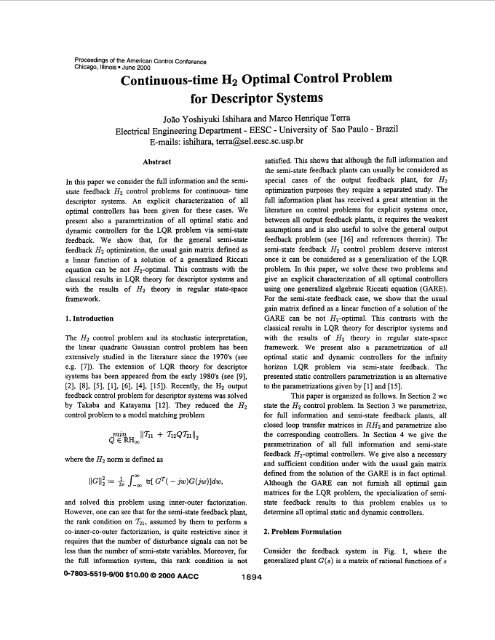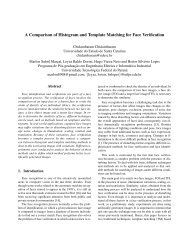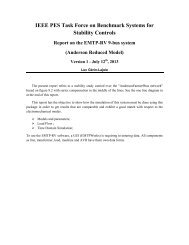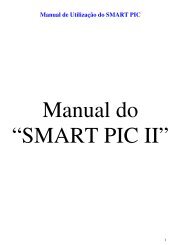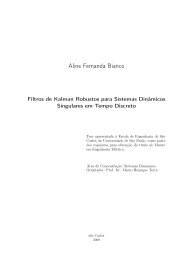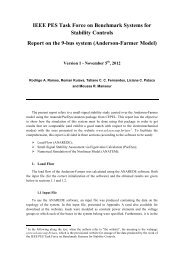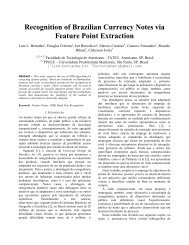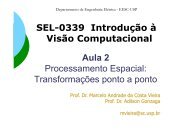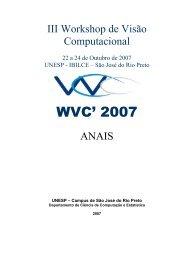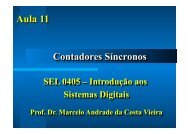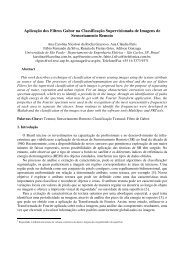optimal control problem for descriptor systems
optimal control problem for descriptor systems
optimal control problem for descriptor systems
Create successful ePaper yourself
Turn your PDF publications into a flip-book with our unique Google optimized e-Paper software.
Proceedings of the American Control ConferenceChicago, Illinois June 2000Continuous-time Hz Optimal Control Problem<strong>for</strong> Descriptor SystemsJoiio Yoshiyuki Ishihara and Marco Henrique TerraElectrical Engineering Department - EESC - University of Sa0 Paul0 - BrazilE-mails: ishihara, terra@sel.eesc.sc.usp.brAbstractIn this paper we consider the full in<strong>for</strong>mation and the semistatefeedback H2 <strong>control</strong> <strong>problem</strong>s <strong>for</strong> continuous- time<strong>descriptor</strong> <strong>systems</strong>. An explicit characterization of all<strong>optimal</strong> <strong>control</strong>lers has been given <strong>for</strong> these cases. Wepresent also a parametrization of all <strong>optimal</strong> static anddynamic <strong>control</strong>lers <strong>for</strong> the LQR <strong>problem</strong> via semi-statefeedback. We show that, <strong>for</strong> the general semi-statefeedback H2 optimization, the usual gain matrix defined asa linear function of a solution of a generalized Riccatiequation can be not H2-<strong>optimal</strong>. This contrasts with theclassical results in LQR theory <strong>for</strong> <strong>descriptor</strong> <strong>systems</strong> andwith the results of H2 theory in regular state-spaceframework.1. IntroductionThe H2 <strong>control</strong> <strong>problem</strong> and its stochastic interpretation,the linear quadratic Gaussian <strong>control</strong> <strong>problem</strong> has beenextensively studied in the literature since the 1970's (seee.g. [7]). The extension of LQR theory <strong>for</strong> <strong>descriptor</strong><strong>systems</strong> has been appeared from the early 1980's (see [9],PI, PI, PI, 111, [61, PI, [151). Recently, the H2 outputfeedback <strong>control</strong> <strong>problem</strong> <strong>for</strong> <strong>descriptor</strong> <strong>systems</strong> was solvedby Takaba and Katayama [12]. They reduced the Hz<strong>control</strong> <strong>problem</strong> to a model matching <strong>problem</strong>where the H2 norm is defined asand solved this <strong>problem</strong> using inner-outer factorization.However, one can see that <strong>for</strong> the semi-state feedback plant,the rank condition on 121, assumed by them to per<strong>for</strong>m aco-inner-co-outer factorization, is quite restrictive since itrequires that the number of disturbance signals can not beless than the number of semi-state variables. Moreover, <strong>for</strong>the full in<strong>for</strong>mation system, this rank condition is not0-7803-551 9-9/00 $1 0.00 0 2000 AACC1894satisfied. This shows that although the full in<strong>for</strong>mation andthe semi-state feedback plants can usually be considered asspecial cases of the output feedback plant, <strong>for</strong> H2optimization purposes they require a separated study. Thefull in<strong>for</strong>mation plant has received a great attention in theliterature on <strong>control</strong> <strong>problem</strong>s <strong>for</strong> explicit <strong>systems</strong> once,between all output feedback plants, it requires the weakestassumptions and is also useful to solve the general outputfeedback <strong>problem</strong> (see [16] and references therein). Thesemi-state feedback Hz <strong>control</strong> <strong>problem</strong> deserve interestonce it can be considered as a generalization of the LQR<strong>problem</strong>. In this paper, we solve these two <strong>problem</strong>s andgive an explicit characterization of all <strong>optimal</strong> <strong>control</strong>lersusing one generalized algebraic Riccati equation (GARE).For the semi-state feedback case, we show that the usualgain matrix defined as a linear function of a solution of theGARE can be not H2-<strong>optimal</strong>. This contrasts with theclassical results in LQR theory <strong>for</strong> <strong>descriptor</strong> <strong>systems</strong> andwith the results of H2 theory in regular state-spaceframework. We present also a parametrization of all<strong>optimal</strong> static and dynamic <strong>control</strong>lers <strong>for</strong> the infinityhorizon LQR <strong>problem</strong> via semi-state feedback. Thepresented static <strong>control</strong>lers parametrization is an alternativeto the parametrizations given by [ 11 and [ 151.This paper is organized as follows. In Section 2 westate the Hz <strong>control</strong> <strong>problem</strong>. In Section 3 we parametrize,<strong>for</strong> full in<strong>for</strong>mation and semi-state feedback plants, allclosed loop transfer matrices in RH2 and parametrize alsothe corresponding <strong>control</strong>lers. In Section 4 we give theparametrization of all full in<strong>for</strong>mation and semi-statefeedback H2-<strong>optimal</strong> <strong>control</strong>lers. We give also a necessaryand sufficient condition under with the usual gain matrixdefined from the solution of the GARE is in fact <strong>optimal</strong>.Although the GAM can not furnish all <strong>optimal</strong> gainmatrices <strong>for</strong> the LQR <strong>problem</strong>, the specialization of semistatefeedback results to this <strong>problem</strong> enables us todetermine all <strong>optimal</strong> static and dynamic <strong>control</strong>lers.2. Problem FormulationConsider the feedback system in Fig. 1, where thegeneralized plant G(s) is a matrix of rational functions of s
and is described by a <strong>descriptor</strong> system (1). The H2 <strong>control</strong><strong>problem</strong> is to find a rational <strong>control</strong>ler K(s), in <strong>descriptor</strong><strong>for</strong>m, such that(i) the feedback system of Fig. 1 is internally stabilizing(ii) the closed loop transfer matrix from w to z, T,, =Gl1 + G&(I - G22K)-lG21, has minimum H2 norm11 Tzw I 12.intemally stabilizing <strong>control</strong>ler to the closed loop system ofFig. 1. Under these conditions there exist matrices F and Lsuch that (E, A + B2F) and (E, A + LC2) are regular,stable and impulse-free. The condition (iv) is assumed,without loss of generality, in order to simplify 'thecomputations.As usual, the <strong>control</strong>ler parametrization can beobtained via doubly coprime factorization technics([3],[13]). For the following two theorems we define thetransfer matrices :UFig. 1. Feedback system.The purpose of this paper is to solve the H2 <strong>control</strong><strong>problem</strong> <strong>for</strong> the full in<strong>for</strong>mation (FI) and semi-statefeedback (SF) cases.3. Determination of All Closed Loop Transfer Matricesin RH2In this section we consider the systemwherea: E Rn,w E Wd, U E W", t E WPandy E WQ, are thesemi-state, the exogenous disturbance, the <strong>control</strong> signal,the <strong>control</strong>led output and the measured output respectively.We assume also that E E W""", ranlcE = r andi) (E, A) is regular, that is, det(sE - A) # 0 (1.2)ii) (E, A, Bz) is finite dynamics stabilizable and impulse<strong>control</strong>lable (1.3)iii) ,( C2, E, A) is finite dynamics detectable and impulseobservable (1-4)iv) 022 = 0. (1.5)With condition (i), we can define the transfermatrices from (w,u) to (z,y). We denote the transfermatrix of the generalized plant (1) byThese matrices Gi, are rational but not necessarily proper.The conditions (ii) and (iii) guarantee the existence of anTheorem 1. (The full in<strong>for</strong>mation case). Consider the fullin<strong>for</strong>mation plant1E.I A] B1 B2Dll D12where (E, A) is regular and (E, A, B2) is finite dynamicsstabilizable and impulse <strong>control</strong>lable. For any F such that(E, A + B2F) is regular, stable and impulse-free and any@ E Wmd, we have that all admissible closed loop transfermatrices can be expressed asand all stabilizing <strong>control</strong>lers are described asTheorem 2. (The semi-state feedback case). Consider theplantGS, - [yy$+1895
where (E,A) is regular and (E,A, B2) is finite dynamicsstabilizable and impulse <strong>control</strong>lable. For any F such that(E, A + B2F) is regular, stable and impulse-free, we havethat all stable closed loop transfer matrices are given byand the set of all <strong>control</strong>lers internally stabilizing the plantis given bywhich there exists Q E RH, such that Tzw(Gs~) E RH2K = F+ (I, + QD~~,(SE-A-B~F)-'B~)-*QD~~,(2) are given byi) Ker Bzl C KerDllwhere Q E RH,,det(sE-A - B2(F - QD21,)) # 0 andCP is an arbitrary matrix of compatible dimension.0We consider now the characterization of the set of allstrictly proper admissible transfer matrices <strong>for</strong> the fullin<strong>for</strong>mation and semi-state feedback plants, i.e. we search<strong>for</strong> conditions under which T,,(G~F), T,,(GFI) E RH2.For this, consider the SVD coordinate system [ 11 such thatThere exists Q E RH, such that Tzw(Gs~) E RH2 if andonly if there exists 0 = [ 01 0 2 ] satisfyingGF(OO) + UF(OO)OVF(O~) = 0or equivalently,[D12 - (C12 + D12fi)(A22 + B22f~)-~B221.@z(Azz + B22f2m21= [Dll - (C12 + D12f2)(A22 -I- B22f2)-1B211. (4)Lemma 3, The necessary and sufficient conditions underLemma 4. The necessary and sufficient condition <strong>for</strong> whichthere exists @ such that GF E RH2 is given by thecondition (ii) of the Lemma 3. In this case, choosingCP = @ I, where CP1 is solution ofwe have that all Tzw(G~~)E RH2 are parametrized by :where C E R'"' is diagonal and positive definite andU = [ 21, V E Etnzn are orthogonal. For F E Etmzn wewrite accordingly FV = [ f1 f2]. With D212 = VT weobtainIf the conditions (i) and (ii) of Lemma 3 hold, then we canchooseIn this case, all TZ,(Gs~) E RH2 are parametrized by :v, = [P!g/?zp]E I All + B12fll A12 + &2f2I B111where Q E RH,, &(CO) = [ 01 021 with 01 free and0 2 solution of (4), det(sE-A - B2(F - QDzl,)) # 0.4. The H2 Optimization ProblemIn this section we will solve the H2 optimization <strong>problem</strong><strong>for</strong> the full in<strong>for</strong>mation and the semi-state feedback plants.We will consider the following generalized Riccati equation(GARE) :ETX = XTEATX + XTA + CTCi - (CTD12 + XTB2).(7.1)1896
a stabilizing solution. Then the minimal value of norm HZof the closed loop system is given by :We say that the GARE has a stabilizing solution if thereexists X satisfying (7) such that (E, A + B2F2) is regular,stable and impulse free. A sufficient solvability condition<strong>for</strong> the GARE (7) is given by Lemma 4 of [ 121.4. 1. The full in<strong>for</strong>mation H2 optimization <strong>problem</strong>The necessity of studying this particular plantseparately results from the fact that the FI plant studied heredoes not fit the assumptions made to the output feedbackplant studied in [12]. In fact, their assumption (CAO) <strong>for</strong>DZl can not be satisfied even rewriting the system, since thenumber of measured signals is not lower than the number ofdisturbance signals.Theorem 5. Assume that the FI plant of Theorem 1 satisfy(ii) of Lemma 3 and is such that the GARE (7) has astabilizing solution. Consider F2 given by (8) and Q1solution of (5). Then the minimal value of norm H2 of theclosed loop system is given by :whereFurthermore, the class of all <strong>optimal</strong> stabilizing c&trollersis given byK = zii + z12(L - Q1Z22)-1Q1Z21whereQ1 E RH,, det(1, - QlZ22) # 0. In particular, <strong>for</strong>Q1 = 0, we have uOpt = F2x + @lw. 04. 2. The semi-state feedback H2 optimization <strong>problem</strong>One can obtain an HZ <strong>optimal</strong> <strong>control</strong>ler to the SFcase as a particular result of the output feedback plantstudied in [12]. However, their assumption (CA9 is quiterestrictive since it is equivalent to the condition B1 with fullrow rank, that is, it requires more disturbance signals thansemi-state variables. Also, the derivation of all <strong>optimal</strong><strong>control</strong>lers is not direct in that context.Theorem 6. Assume that the SF plant of Theorem 2 satisfy(i) and (ii) of Lemma 3 and is such that the GARE (7) haswhere- [E I A+BzF21 IGF? =Cl + D12Fz I Dll B1+B2@2 + D12@2 1 .Furthermore, the class of all <strong>optimal</strong> stabilizing <strong>control</strong>lersis given byKopt = Fz + (I + (Q + WII)B2)-'..(Q + WlJ)(sE - A - B2F2) (9)whereFZ is given by (8)II := (I- BIB:), Bf is the Moore-Penrose inverse of B10 2 solution of (4) with F = F2Q := [ 0 02(A22 + BZ2f2)-' ]U, U is the orthogonalmatrix used in the SVD (3)a2 = 02G422 + B22f2PB21W E RH2 and Q are such thatdet(l+ (9 + WII)B2) # 0 0It is known that <strong>for</strong> the solution of LQR <strong>problem</strong>,alternative GAREs could be used (see e.g. [8], [4]). Oneinteresting consequence in adopting the GARE (7) is that,in the general semi-state feedback H2 <strong>problem</strong>, there aresituations where we can not use U = F2x =- ( D:ZD~~)-'(DT~C~ + BFX)~as an <strong>optimal</strong> <strong>control</strong>signal. In the following lemma we state a necessary andsufficient condition to the plant under which we have F2 asthe usual <strong>optimal</strong> feedback gain.Lemma 7. A necessary and sufficient condition under whichwe can choose Kopt = F2 is GF?(co) = 0. A sufficientcondition <strong>for</strong> this is given by Dll = 0 andBTKerET = (0). 0Another consequence in adopting the GARE (7)becomes clear when we specialize the results to the usualLQR <strong>problem</strong> ([l], [ti]).E&(t) = AX(^) + Bzu(t), Ex(O-) = EXO (10.2)Theorem 8. Consider the LQR <strong>problem</strong> (10) with thefollowing assumptions(i) (E, A) is regular1897
(ii) (E, A, B2) is finite dynamics stabilizable and impulse<strong>control</strong>lable(iii) the GARE (7) has a stabilizing solutionIn this case, all <strong>optimal</strong> <strong>control</strong>lers u(t) can be obtained bythe Laplace inverse of U(.) = K(s)z(s) whereK(s) = F2 - (I + (Z + W(S)UT)U~B~)-'..(E + W(S)U,T)U~(A + B2F2)andW(s) E RH2, E E Rm"(n-') are such that# odet(I + (Z + WU,T)U~B~)F2 is given by (8)U = [ 21 is the orthogonal matrix used in the SVD (3).In particular, all static <strong>optimal</strong> <strong>control</strong>lers are parametrizedasK = F2 - (I + EU2&)-'E:V2(A + B2F2), (1 1)z E R"+-'), det(I + EU~B~)# 0.Furthermore, the <strong>optimal</strong> cost is given byUThe parametrization in Z, (11), of the set of all <strong>optimal</strong>static <strong>control</strong>lers to the LQR <strong>problem</strong> is an alternative to thecharacterizations given by [ 13 and [ 151. Also, (11) confirmthe statement of [ 11 p. 686 that: "There is a linear variety ofoperators relating the <strong>control</strong> ~ (t) to the <strong>descriptor</strong> variabletrajectory z(t); the dimension of this variety is mz(n - T),the rank defficiency of E times the number of inputs (thedimension of the matrix S)".5. ConclusionsIn this paper we have solved the H2 <strong>control</strong><strong>problem</strong> <strong>for</strong> <strong>descriptor</strong> <strong>systems</strong> in two particular cases: theFI and the SF cases. An explicit characterization of all<strong>optimal</strong> <strong>control</strong>lers has been given <strong>for</strong> the FI, SF and <strong>for</strong> theLQR <strong>problem</strong>. We have shown that, in the SF case, theusual gain matrix F2 defined as a function of a solution of aGARE can be not <strong>optimal</strong>. This contrasts to the classicalresults in LQR theory <strong>for</strong> <strong>descriptor</strong> <strong>systems</strong> ([l], [14],[15]) and the results of H2 theory to regular state-spaceplants ([16]).AcknowledgmentsThis work was supported by FAPESP (Slo Paul0 StateResearch Council) under grant 98/12113-2.ReferencesD. J. Bender and A. J. Laub, "The linear-quadratic<strong>optimal</strong> regulator <strong>for</strong> <strong>descriptor</strong> <strong>systems</strong>," IEEE Trans.Automat. Control, 32, pp. 672-688, 1987.D. J. Cobb, "Descriptor variable <strong>systems</strong> and <strong>optimal</strong>state regulation," IEEE Trans. Automat. Control, 28,pp. 601-611, 1983.B. A. Francis, A Course in H, Control Theory.Springer -Verlag, Berlin, 1987.T. Katayama, and K. Minamino, "Linear quadraticregulator <strong>problem</strong> and spectral factorization <strong>for</strong>continuous-time <strong>descriptor</strong> <strong>systems</strong>," Proc. 31st IEEECon$ on Decision and Control, pp. 3304-3305, 1992.V. Kucera, "Stationary LQG <strong>control</strong> of singular<strong>systems</strong>," IEEE Trans. Automat. Control, 31, pp. 31-39, 1986.V. Kucera, "The rational H2 <strong>control</strong> <strong>problem</strong>," Proc.31st IEEE Con$ on Decision and Control, pp. 3610-3613, 1992.H. Kwakemaak, and R. Sivan, Linear OptimalControl Theory. Wiley, New York, 1972.F. L. Lewis, "Preliminary notes on <strong>optimal</strong> <strong>control</strong> <strong>for</strong>singular <strong>systems</strong>," Proceedings of 24th IEEEConference on Decision and Control, pp. 266-272,1985.L. Pandolfi, "On the regulator <strong>problem</strong> <strong>for</strong> lineardegenerate <strong>control</strong> <strong>systems</strong>," J. Optim. Theory Appl.,33,241-254, 1981.C. R. Rao and S. K. Mitra, Generalized Inverse ofMatrices and its Applications. John Wiley & Sons,1971.M. A. Rotea, and P. P. Khargonekar, "H2-<strong>optimal</strong><strong>control</strong> with an H,-constraint: the state feedbackcase," Automatica, 27, pp. 307-3016, 1991.[12] K. Takaba and T. Katayama, "H2 output feedback<strong>control</strong> <strong>for</strong> <strong>descriptor</strong> <strong>systems</strong>," Automatica, 34, pp.841-850, 1998.[13] M. Vidyasagar, Control System Synthesis: AFactorization Approach. M.I.T. Press, Cambridge,MA, 1985.141 Y.-Y. Wang, P. M. Frank and D. J. Clements"Robustness properties of the linear quadraticregulators <strong>for</strong> singular <strong>systems</strong>," IEEE Trans.Automat. Control, 38, pp. 96-100, 1993.151 H. Xu and K. Mizukami, "The linear-quadratic<strong>optimal</strong> regulator <strong>for</strong> continuous-time <strong>descriptor</strong><strong>systems</strong>: a dynamic programming approach," Int. J.Systems Sci, 25, pp. 1889-1898, 1994.[16] K. Zhou, J. C. Doyle and K. Glover, Robust andOptimal Control. Prentice-Hall, Englewood Cliffs,New Jersey, 1995.1898


